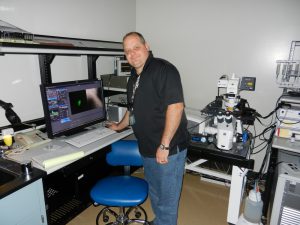 After graduating from Austin College with a degree in biology, Caleb Roth ’00 became a research assistant at UT Southwestern Medical Center at Dallas. He began graduate school and worked at the UT Health Science Center–San Antonio (UTHSCSA), and spent the next nine years as a research scientist for the Air Force Research Labs in the field of bio-electrics. He isn’t comfortable calling himself a success in science—but said he had “been pretty lucky.” One of his most memorable “lucky” moments was the opportunity to meet Dr. James Watson, who discovered the structure of DNA. That, Roth said, was a highlight of his career.
After graduating from Austin College with a degree in biology, Caleb Roth ’00 became a research assistant at UT Southwestern Medical Center at Dallas. He began graduate school and worked at the UT Health Science Center–San Antonio (UTHSCSA), and spent the next nine years as a research scientist for the Air Force Research Labs in the field of bio-electrics. He isn’t comfortable calling himself a success in science—but said he had “been pretty lucky.” One of his most memorable “lucky” moments was the opportunity to meet Dr. James Watson, who discovered the structure of DNA. That, Roth said, was a highlight of his career.
Now pursuing a Ph.D. in radiation biophysics at UTHSCSA, Roth works in the laboratory of Dr. Randolph Glickman in the Department of Radiology of the School of Medicine. In spring 2012, he received a prestigious SMART/ASEE scholarship and is sponsored by the Air Force Research Laboratory 711th HPW. He studies the biophysical properties of mammalian cells exposed to nanosecond-pulsed electrical fields. The crux of his work revolves around using radiofrequency-directed energy as a novel cancer therapy. He specializes in biophotonics and cancer biology.
The SMART program (Science, Mathematics, and Research for Transformation) was established by the Department of Defense (DoD) with a goal to increase the number of civilian scientists and engineers working at DoD laboratories. The SMART program provides full tuition and education fees and a cash stipend, internships, and employment with DoD facilities after graduation.
Roth plans to work at a civil servant for the U.S. Air Force until retirement age—and then he has very specific goals. “I feel very fortunate to have been a student at Austin College, and I miss it tremendously,” he said. “I would like to retire from my job in government life and become a professor of biology at Austin College. That has always been a dream of mine.”
